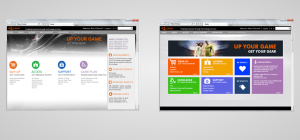Creating a Good User Experience for your Service Portal
During the Knowledge13 event, GFT was invited to present the panel “Service Portal and User Experience – Together at last”. Due to the success of the session, we felt we had to share the insights of a successful UX implementation project with you.
An internal portal can be highly efficient and enjoyable. It is built for a known user base, in a familiar environment and directly impacts the company’s ROI by keeping the employee’s portal work time down and the satisfaction up. By concentrating on the usability and user experience of your portal, you can use the advantage of known users in a known culture and environment to create a highly successful application.
Often times, an out-of-the-box interface will not maximize the power of the portal. Usability expert Jakob Neilsen has said to this point: “It is clear that great intranet design requires companies to modify packaged [out-of-box] solutions to suit their specific needs. You must design a user interface that goes beyond the default settings.”
What goes into a successful user interface design?
One size does not fit all when it comes to creating the best user interface (UI) or user experience. A successful UI needs to be tailor fit to the group of people using it and company it is servicing. Therefore, unlike using a random generic template, the designer must take into account three major principles. First, the portal must address the unique functionality and processes for the users as well as the needs/goals of the company and department. Second, the UI must be designed following usability best practices. We have usability research and guidelines – and applying these best practices provides an easy win towards efficiency and happy users. And last, but not least, the portal should be designed to both the corporate identity (something companies have spent a lot of money and man power creating!) and corporate culture (fitting in with the very people who will be using it).
Here is a deeper look into the three fundamental principles:
1) Understanding unique user needs and company goals
The custom designed user interface must factor in the user needs of multiple sets of users including different skillsets and needed functionality. These needs will be combined with the company and department goals of the current portal such as reducing calls to the service desk or creating automated incident reporting.

2) Implementing usability best practices
In order to create a highly usable and efficient portal for your company, you must factor in many best practice guidelines to create an intuitive and fluid experience.
Usability concepts include:
Minimalism – Google, Apple, Windows 8 – they’ve all taken a minimalistic approach and look at their success. A good UI must keep things simple, digestible and not-chaotic.
Content Chunking – Provide intuitive categorization and hide unnecessary details or options until they are relevant.
Patterns – Humans are all about patterns. Keep usability features consistent across the UI. Therefore users should be able to recognize patterns.
Enabling Growth – No application is ever finished on the first go-live. Nevertheless all UIs must be designed by anticipating growth. This includes navigation, homepage design and graphics.
Handling Failure – No UI is ever created so that every single user will do the “right” thing every time. One way to handle failure is to provide search boxes, common help questions and help numbers for the customer to call. That may not be the most desirable action, but in the end you need satisfied users who got their problems fixed or processes accomplished.
Learnability –If you design with consistent and optimal navigation, layout and process flows, then your users will be able to learn your application quicker. This cuts down on training, increases user confidence and enhances the overall user experience.
Rapid User Testing – It’s as simple as this: with paper prototypes and five users, you can uncover 85% of usability issues You just need paper prototypes, five users and a little time to rework lessons learned – what a quick win for usability!
Guiding Users – Help your users throughout the application. Provide relevant links to processes or products the user may be looking for clearly indicate input field restrictions before they fill it out. Show relevant help articles and an easily accessed search box.
Device Awareness – If your application is going to be used on mobile devices or tablets, the user interface should steer clear of mouse-driven functionality like roll-overs or tool-tips. In the touch-screen world it is important to not rely on desktop computer functionality.
Internationalization – Even when you are trying to make your application slick and cool looking, don’t be lured into creating graphics with text embedded in them. Utilize standard fonts or Google Web Fonts because in the end, your application has to work for your users. Any application can look cutting edge and trendy while still using standard fonts so that translation does not cause any problems.
3) Branding – corporate identity and corporate culture
While usability is essential to an effective portal, the user experience is also driven by perception and engagement. The problem with the world of templates is that while they may look nice enough, they don’t provide a visual look-and-feel that speaks to the specific users of your company. External corporate identity and the work culture are two pieces that are factored into a tailored look.
Employees like feeling proud of where they work and part of the company’s identity is external marketing and advertising. This needs to be brought out in the internal applications.

Happy Users = Successful Projects
Regardless of the goals driving the project, if your users feel engaged and satisfied then the project will succeed. In the end, your user satisfaction will help drive the success of your project and make happier employees.





